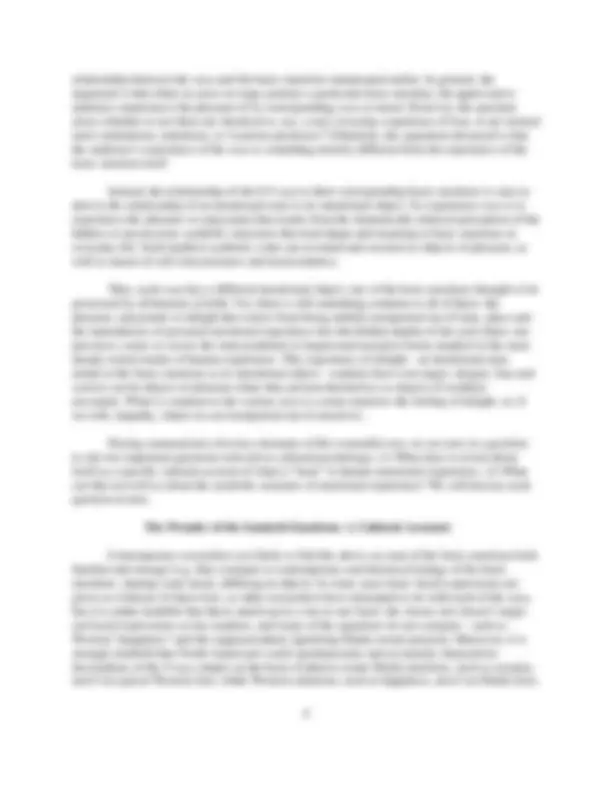








Study with the several resources on Docsity

Earn points by helping other students or get them with a premium plan


Prepare for your exams
Study with the several resources on Docsity

Earn points to download
Earn points by helping other students or get them with a premium plan
Community
Ask the community for help and clear up your study doubts
Discover the best universities in your country according to Docsity users
Free resources
Download our free guides on studying techniques, anxiety management strategies, and thesis advice from Docsity tutors
The cultural significance of emotions through an analysis of ancient hindu texts and contemporary research. How emotions are shaped by cultural ethics and provides insights into the universality and diversity of emotional experiences. It also touches upon the challenges of comparing emotions across cultures and the importance of understanding the symbolic structures that give meaning to emotional experiences.
Typology: Study notes
1 / 11

This page cannot be seen from the preview
Don't miss anything!







Sociology 3308: Sociology of Emotions
Prof. J. Scott Kenney
Lectures 6-7: Cultural Differences in Emotions:
Today we will outline a cultural/symbolic meaning approach to the emotions using both ancient and contemporary sources. Examining the moral context of emotional functioning, we will suggest that the character and meaning of particular emotions are systematically related to the kind of ethic prevalent in a cultural community.
In recent years there have been several major reviews of research on similarities and differences in emotional meanings across cultural groups. There have also been a number of books and essays defining a new interdisciplinary field for cross-cultural research on the emotions known as cultural psychology. The major goals of cultural psychology are to spell out the implicit meanings that give shape to psychological processes, to examine the distribution of those meanings across ethnic groups and temporal-spatial regions of the world, and to identify the manner of their social acquisition. Related goals are to reassess the principle of psychic unity or uniformity, and to develop a credible theory of psychological diversity or pluralism. The emphasis is upon the way the human mind can be transformed and made functional in a number of different ways, which are not equally distributed across ethnic and cultural communities around the world (e.g. AOne mind, but many mentalities; universalism without uniformity@).
Cultural psychology first exhibits a conception of culture that is both symbolic and behavioral. It can be defined as ideas about what is true, good, beautiful and efficient that are made manifest in the speech, laws and customary practices of a self-regulating group. Culture thus consists of meanings, conceptions, and interpretive schemes that are activated, constructed and brought online through participation in normative social institutions and routine practices (including linguistic ones). Thus, a culture is that subset of possible available meanings which, through enculturation (formal/informal, implicit/explicit, unintended/intended) has become active in giving shape to the psychological processes of the individuals in a group.
Secondly, cultural psychology exhibits the idea that interpretation, conceptualization, and other Aacts of meaning@ can take place rapidly, automatically, and unselfconsciously. Indeed, it is assumed that acts of meaning (e.g. the judgement that the human body, as a temple for the soul, may become polluted in certain circumstances) can take place so rapidly, automatically, and unselfconsciously that, from the individual=s viewpoint, they are indistinguishable from Araw@ experience or Anaked@ consciousness. Hence, many rapid, automatic and unselfconscious psychological processes are not best understood as Apure,@ Afundamental,@ or Aintrinsic,@ but rather as content-laden processes which are contingent on the implicit meanings, conceptual schemes and interpretations that give them life.
Given the above, the intellectual agenda of cultural psychology in the study of the
emotions can be defined by four questions:
Any comprehensive review of answers to these questions would have to address hundreds of years of anthropological work. Hence, my aim today is simply to formulate the first two of these questions in ways that seem promising, provocative and productive for future research.
Specifically, I begin in3rd century India with a relatively detailed examination of a Sanskrit text (the Rasadhaya) written relatively close to the beginning of systematic historical consciousness of the emotions. Through analysis of this text - an ancient example of cultural psychology - the above concerns are addressed. This is a useful exercise for a discussion of the cultural psychology of emotions because: (1) the text compares favorably with any contemporary treatise on the symbolic character of emotional experience; (2) it is hardly known by emotion researchers in anthropology and psychology; and (3) it provides the opportunity for an object lesson about the universally appealing yet culturally revealing character of all accounts about what is Abasic@ to the emotional nature of human beings.
The Basic Emotions of the Rasadhaya:
In Sanskrit, the word for Aexistence@ and Amental state@ are the same, and mental states are said to bring into existence the essence of poetry. It is thus not surprising to find that between the 3rd^ and 11th^ centuries Hindu aesthetic philosophers posited the existence of 8 or 9 basic emotions and developed a relatively detailed account of the symbolic structures that give them shape or meaning. These basic emotions are variously translated as:
(1) sexual passion, love or delight; (2) amusement, laughter, humor or mirth; (3) sorrow; (4) anger; (5) fear or terror;
relationship between the rasa and the basic emotions enumerated earlier. In general, the argument is that when an actor on stage portrays a particular basic emotion, the appreciative audience experiences the pleasure of its corresponding rasa or mood. However, the question arises whether or not these are identical to, say, a real, everyday experience of fear, or are instead mere simulations, imitations, or vicarious pretenses? Ultimately, the argument advanced is that the audience=s experience of the rasa is something entirely different from the experience of the basic emotion itself.
Instead, the relationship of the 8-9 rasa to their corresponding basic emotions is seen as akin to the relationship of an intentional state to its intentional object. To experience rasa is to experience the pleasure or enjoyment that results from the dramatically induced perception of the hidden or unconscious symbolic structures that lend shape and meaning to basic emotions in everyday life. Such implicit symbolic codes are revealed and savored as objects of pleasure, as well as means of self-consciousness and transcendence.
Thus, each rasa has a different intentional object: one of the basic emotions thought to be possessed by all humans at birth. Yet, there is still something common to all of these: the pleasure, enjoyment or delight that comes from being artfully transported out of time, place and the immediacies of personal emotional experience into the hidden depths of the soul where one perceives, tastes or savors the transcendental or impersonal narrative forms implicit in the most deeply rooted modes of human experience. This experience of delight - an intentional state aimed at the basic emotions as its intentional object - explains how even anger, disgust, fear and sorrow can be objects of pleasure when they present themselves as objects of aesthetic encounter. What is common to the various rasa is a meta-emotion: the feeling of delight, or, if we will, empathy, where we are transported out of ourselves.
Having summarized a few key elements of this venerable text, we are now in a position to ask two important questions relevant to cultural psychology: (1) What does it reveal about itself as a specific cultural account of what is Abasic@ to human emotional experience. (2) What can this text tell us about the symbolic structure of emotional experience? We will discuss each question in turn.
The Wonder of the Sanskrit Emotions: A Cultural Account:
Contemporary researchers are likely to find the above account of the basic emotions both familiar and strange (e.g. they compare to contemporary and historical listings of the basic emotions, sharing some items, differing in others). In some cases basic facial expressions are given as evidence of these lists, as other researchers have attempted to do with each of the rasa, but it is rather doubtful that these match up in a one to one basis: the classic text doesn=t single out facial expressions as key markers, and many of the equations do not compare - such as Western Ahappiness@ and the supposed photo signifying Hindu sexual passion). Moreover, it is strongly doubtful that North Americans could spontaneously and accurately characterize descriptions of the 9 rasa simply on the basis of photos (some Hindu emotions, such as serenity, aren=t on typical Western lists, while Western emotions, such as happiness, aren=t on Hindu lists).
Any suggested correspondences must be more apparent than real.
Reading the Sanskrit text and commentaries, three of the basic emotions are genuinely familiar to contemporary North Americans (i.e. anger, fear and sorrow). This does not necessarily mean that they are cross-cultural universals. Anthropological linguists have shown that superficial similarities do not necessarily translate into universals (e.g. Asadness@ as understood in the West is not an empirical universal, and not lexicalized, important or salient in most world languages). Nevertheless, these three emotions are easy to recognize in the Sanskrit text, as are their causes and appropriate behaviors (e.g. sorrow arises from misfortune or separation from those who are dear, and is to be acted out by tears, laments, etc.) For these three emotions it is easy to recognize the underlying script, to see the self in the other, and to arrive at a cross-cultural and trans-historical agreement about what is basic about emotional functioning.
Yet, as we move beyond these three emotions to consider disgust, amusement, wonder, perseverence, sexual passion and serenity, the way in which early Hindu consciousness is partitioned or hierarchically structured into basic and non-basic states seems less and less familiar, despite any initial appearances to the contrary. For example, Medieval Hindu Adisgust@ differs from our own. It is partitioned, first, into horror, disillusionment and world-weariness associated with the quest for detachment, transcendence and salvation, and secondly into horror at the sight of blood. In contrast, contemporary North American disgust more often centres around moral issues. Similarly, Medieval Hindu Awonder@ is closely related to admiration of divine, heavenly or exalted feats, while their conception of Aamusement@ (including contemptuous, indignant or derisive laughter at the faults/inferiority of others) does not relate well to North American Ahappiness,@ and what we would call Acontempt@ is considered a non- basic mental state by the texts. Finally, Medieval Hindu perseverance is not North American Ainterest,@ but related to heroic determination, endurance, and self-sacrifice (not really considered emotions per se in this culture, but moral virtues). In sum, contemporary listings of basic North American emotions (Ekman=s being the example here) only overlap significantly at three points (anger fear and sorrow) while the correspondence between the two lists turns out to be merely apparent. Indeed, for several of the emotions (e.g. serenity) there is not even an illusion of transcultural equivalence.
In addition to such attempts at comparison, there are other ways in which the ancient text presents us with a rather unfamiliar portrait of the way consciousness is organized. One has to do with the way the text divides the basic emotions into primary and secondary basic emotions (primary = sexual passion, anger, perseverence, disgust and sometimes serenity; secondary = amusement, sorrow, wonder and fear). While Freud might have found much of value in a conception treating the above list as the primary, basic emotions, it is more important to recognize that this list is associated in classical and folk Hindu thought with the four worthy goals of life. One of these (pleasure) is linked to sexual passion. A second one (control, autonomy and power) is linked to anger. Third, social duty and moral virtue is linked to perseverence. Finally, salvation/attainment of divinity is linked to disgust and/or serenity. In sum, presupposed by the textual formulation of the organization of primary human emotions are theories of morality, human motivation, and a specific way of life. Thus, it is hardly surprising
of aesthetic pleasure in the theatre), and then to define that symbolic structure by resolving it into its determinants, consequences and accompanying side effects. This strategy is directly parallel to various contemporary approaches in the cultural psychology of emotions.
One aspect of this symbolic or cognitive approach is that emotions are not things like rocks, but interpretive schemes of a particular script-like, story-like or narrative kind that give shape and meaning to the human experience of those conditions of the world that have a bearing on self-esteem. The elements that are proposed as slots in the story may vary slightly from scholar to scholar, though most of the slots in use today can be found in the Sanskrit text as well.
The primary assumption of the symbolic approach is the same as that in the Medieval Hindu text: emotions are not something independent of or separable from the conditions that justify it, from the somatic and affective events that are ways of feeling or being touched by it, from the actions it demands, or the like. The Aemotion@ is the whole story: a kind of somatic event (fatigue, chest pain), and/or affective event (panic, emptiness), experienced as a perception of some antecedent conditions (death of a friend), and their implications for the self (as a loss), and experienced as well as a social judgement (vice or virtue), and as a kind of plan of action to preserve one=s self-esteem (withdraw, hide, explore). The Aemotion@ here is the entire script: the simultaneous or unitary experience of all the components: the whole package deal.
A second aspect of the symbolic approach is the view that for the sake of comparison and translation, any emotion is decomposable into its narrative slots. Thus, to ask whether people are alike or different in their emotional functioning (and whether emotion words in different languages are alike or different in their significations) is really to ask several more specific questions relating to the different scriptural components:
Given this type of decomposition of the definition of an emotion to its constituent narrative slots, the issue of translation equivalence becomes a matter of pattern matching - of determining whether the variables in each of these slots are linked in similar ways across cultures.
Bite Your Tongue: The Case of Hindu Lajja:
A good example of this approach is an analysis of the contemporary Hindu conception of lajja that has recently been completed for two communities in South Asia (the Newars of Bhaktapur in Nepal and the Oriyas of Bhubaneswar in Orissa, India). Lajja is often translated as Ashame,@ Aembarrassment,@ Ashyness@ or Amodesty,@ but every one of these translations is problematic.
To begin, lajja is something one deliberately shows or puts on display like we would gratitude, loyalty or respect. It considered a supreme virtue, especially for women, and is routinely exhibited in everyday life. It is both an emotion and a moral state whereby the civilized uphold the social order (e.g. by showing perseverence in one=s role obligations, showing respect for one=s superiors, acting shy, modest, and not encroaching on others= prerogatives, etc.).
While lajja may be experienced by both men and women, it is an emotion and a virtue associated with a certain feminine ideal - especially as reflected in the legend of the mother goddess Kali who stopped a rampage elicited by male humiliation and deceit when, in committing an act of supreme disrespect to her husband, the god Siva, came t her senses, bit her tongue, and became calm and still. To this day in Orissa, Abite your tongue@ is an idiomatic expression for lajja and an expressive facial gesture given by women as an apology when they are confronted with the fact that they have failed to uphold social norms. In a patriarchal society, this is often taken as evidence that while men humiliate women, women are relied on to make the world go round. It is also a salient ideal because it preserves social harmony by helping women to swallow their rage.
If we deconstruct lajja into its constituent narrative slots it becomes apparent just how hazardous it can be to assume that we can render the emotional meanings of others with English terms for mental states. Hindu lajja does not map well onto terms like shame, embarrassment, shyness, modesty or stage fright. For example, from the perspective of social appraisal and self- appraisal, to be full of lajja is to be in possession of the virtue of behaving in a civilized manner, and in such a way that the social order and its norms are upheld. It isn=t a neurosis, nor does it connote a reduction in the strength of the ego. Indeed, it promotes self-esteem, and to be defined as someone without lajja is unpleasant and arouses blushing, sweating, and increased pulse rate.
The environmental determinants of lajja as a sense of one=s own virtue and civility re as varied as the set of actions that are dutiful and responsible - given one=s station in life in a world in which all are highly self-conscious about their social designation. These include events that we would consider familiar (e.g. not being seen naked by the wrong person), as well as many events that might be seen as alien or strange (e.g. never talking directly to one=s husband=s elder brother or father in law; never being in the same room with one=s husband and another male to whom he must defer).
From the perspective of self-management, South-Asian lajja may appear at first glance to be similar to our conceptions of shame and embarrassment (e.g. hiding, covering up and withdrawing), yet but what is really being activated is a general habit of respect for the social
heroism may require some strong attachment and dedication to a collectivity or group.
The third ethic - that of divinity - may have a similar differential activation and enabling effect on emotional life. Here, people (and sometimes animals) are seen as containing a bit of God within them, and the central moral goods are those that protect and dignify the person=s inherent divinity. The body is experienced as a temple, so matters that seem to be personal choices within the ethics of autonomy (e.g. food, sexual choices, personal hygiene) become moral and spiritual issues associated with such goods as sanctity, purity and pollution. Even love and hate may lose their simple hedonistic connotations. Instead, they may be seen as attachments that fetter an individual and prevent him or her from rising to their true stature. Hindu scriptures are full of stories encouraging such viewpoints and discussing associated feelings of disgust that may not be fully explicable to those who are not immersed in an ethic of divinity. To be sure, Western folk may feel pride upon giving up an attachment to cigarettes or even to money, but these are more likely to be seen as personal accomplishments - not as purifications leading one=s soul toward reunion with God.
Moreover, within this ethic, the very idea of emotion connected with renunciation seems paradoxical: spiritual progress in many Eastern religions is measured by the degree to which one moves beyond the experience of emotions. Only once this paradox is grasped does the Hindu conception of serenity make sense. This is an important part of Hindu emotional life and discourse precisely because of the centrality of an ethics of divinity in everyday life. Not surprisingly, it is on no Western lists of basic emotions.
Conclusion: The Cultural Psychology of the Emotions Anew:
As anthropologists, psychologists and others increasingly collaborate in studying the similarities and differences in emotional functioning on a worldwide scale, a major goal for the cultural psychology of the emotions will be to deconstruct the emotions and their languages into constituent narrative slots. It is hoped that by this method it will be possible to render the meanings of other people=s mental states without assimilating them in misleading ways into easily available words in the language of the researcher.
It is one of the great marvels of life that across languages, cultures, and history, it is possible, with sufficient knowledge, effort and insight, to truly understand the meanings of other people=s emotions and mental states. Yet we must also marvel at one of the great ironies of life: that this can appear far easier than it really is, which makes it even harder to achieve genuine understanding of Aotherness.@ Thus, in the end, this is really a plea for the method of deconstructing emotional states into their constituent narrative slots. Unless we take that step, we will continue to be prone to the bias that the emotional life of human beings is Abasically@ the same around the world. The truth may well be that when it comes to Abasic@ emotions we are not only basically alike in some ways, but basically different from each other as well.